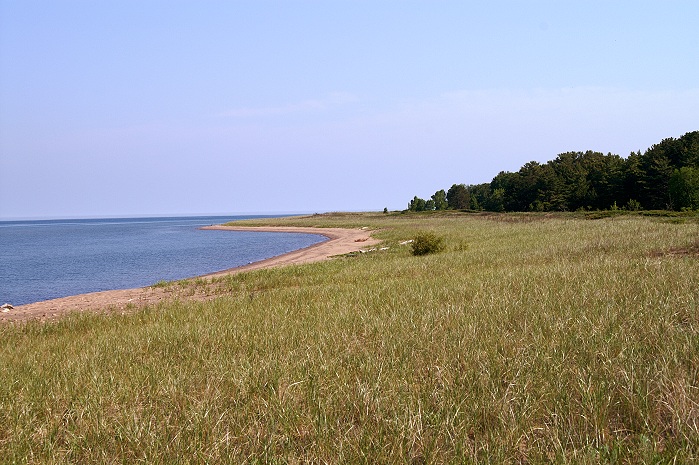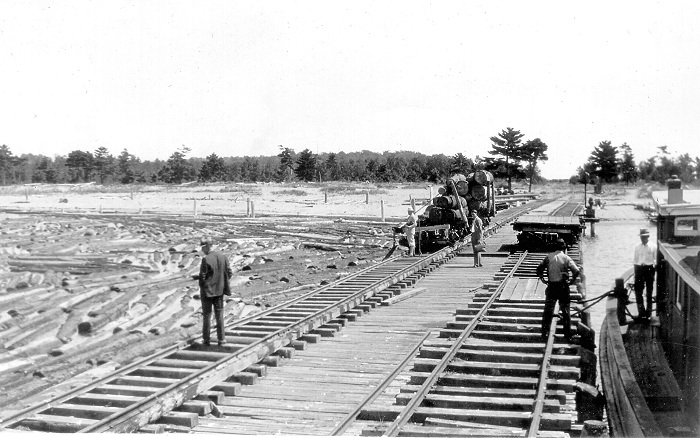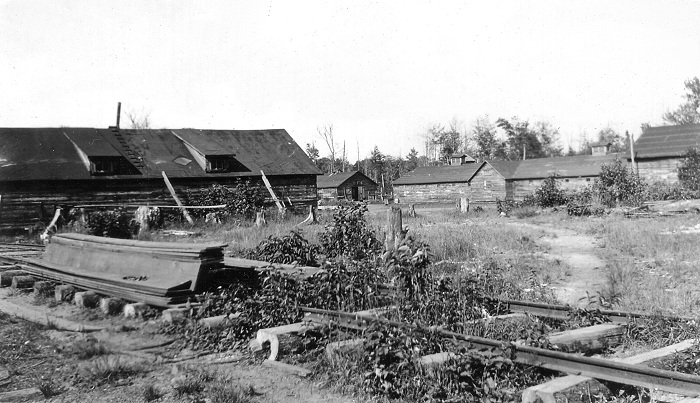Fish Tugs of the Greatest Lake
Sixty-One Years
An Unfinished Memoir
By Harvey F. Hadland

Outer Island South End, 2006
Editor's note: In recent weeks, thanks to the generosity of Cliff Hadland, I have had the sad honor of going through his brother Harvey's collected papers. Among them was this undated fragment of an unfinished autobiography, telling of life at his family's fish camps on Outer and Stockton Islands in the 1930s. The title gives a hint of the intended scope, never achieved. We are fortunate nonetheless to have this vignette of a long-vanished way of life.
-Bob Mackreth, July 20, 2013
My earliest memories are of being on an island in Lake Superior, and having unlimited space before me and running along what seemed to be an endless expanse of beach stretching as far as my young eyes could see, a place where I spent many an hour along the water's edge in total fascination of the shimmering shadows of waves reflecting off the lake bottom. The water was so clear it was nearly invisible, and small stones on the bottom were visible out to where the water deepened and the bottom disappeared. The top edge of the beach was bordered with a jumble of driftwood sun-bleached logs and driftwood beyond which a sparse growth of sharp edged beach grass extended inland to a stand of tall wind-deformed pine and hemlock along the eastern shoreline of the narrow sand point, forming a barrier to the prevailing off-lake winds.
Nestled in the shelter of the trees was the fishing camp of my father Chris Hadland, and my uncle Thomas Dyrness, where I spent two summers surrounded by all the activity associated with commercial fishing, a lifework I was destined to pursue in future years. The camp area consisted of several small cabins, one built of logs and several others of lumber and covered with black tarpaper; also a large twine shed, a number of net reels and a platform for drying cedar net floats.
Nearly on the west shoreline was a short dock, built on large sawhorses connected by stringers and covered with a plank deck. Being close to the twine shed and net reels made loading and unloading nets and other fishing equipment here convenient. The fish buying boats, C.W. Turner and Chinook also docked here when the weather was favorable. They came on alternating days six days each week.
A short distance to the north a 600-foot piling dock extended into the lake; topped with two sets of narrow-gauge railroad tracks, this dock was also used by the fishermen, on a limited scale, it being rather high and in poor condition. A rail-line came down from the abandoned logging camp in the center of the island to a point near the east shore, where it turned and went in a straight line to the big dock. Two locomotives had been employed in bringing down gondola loads of logs which were dumped in the lake and held behind large boom logs until tugs arrived and rafted them to mills on the mainland.

Outer Island railroad dock, 1930
In the area where the tracks turned to the west were two buildings. One had been used as a laundry shed and the other as living quarters for the man-and-wife crew who did the washing for the loggers. This became our home for part of our first summer on the island; nestled in a grove of large pines that gave some shelter from off-lake winds. The rail line provided a means of moving supplies up from the west side. The place, however, was very inconvenient being so far from the fish camp. Water had to be carried up from the beach in pails, and when it was windy a trip down to the big dock and haul water back with a four wheel handcar was necessary. There was no means of keeping perishable food other than a root cellar outside the cabin door. Of the four small windows on the cabin, two had screens, but no sashes and had to be covered on the outside during the night and when it was cold and windy. Bats always seemed to get in behind the covers, and their chirping and scratching was constant entertainment during the night. When it rained the roof leaked in a number of places and on windy nights trees branches sent a constant shower of rain against the walls making for a regular symphony day and night.
On one occasion, while staying in this cabin, a strong wind from northeast came up while the men were out on the lake, it became so strong that landing at the island was unwise and they continued on to Bayfield, leaving mother, my one year old brother Clifford and I alone. We had plenty of food and fuel, but had to make several trips down to the big dock for water. These late spring blows usually lasted three days, so our ordeal must have lasted several days.
During periods of sunny weather I can remember mother putting us on the handcar and going along the tracks gathering bark that had fallen of the gondola loads of logs, and were now after so many years very dry and an excellent fuel for the cook stove. At some time that summer we moved to the west side of the sand point, close to the big dock, and lived in a log cabin originally built farther north, near the slough. Here we were much closer to the everyday goings-on, the fish buyboat arriving in the afternoon, and I could see when dad and Uncle Tom came in from fishing.
Not being at a loss for finding things to keep me occupied, I had come upon an old skiff sitting high and dry at the south end of the point, and rigged it out as a fishing boat, using pieces of driftwood to represent the main engine and the netlifter and steering wheel. One morning while in my boat, two men came rowing toward the island and pulled their skiff ashore nearby. They came up to where I was so busily occupied, and asked me what I was doing. When I replied that I was about to lift a gang of nets, they were much amused, and after a short while they went up the shore to visit. When they came back, and were getting ready to leave, they were not so amused when it was discovered their oars were missing. When I was asked about the oars I replied that I had thrown them in the lake. Luckily my mother had arrived also, and she was able to wade out and retrieve the oars. It was flat calm and the oars were close by the shoreline. With that the men, Theodore Olsen and Gottfred Bark, both from Bayfield, launched their skiff and began rowing toward Stockton Island. Mr. Olsen reminded me of this incident many times in later years.
Besides being taken up with things down on the point there was much to take up the time closer to where we lived. In the area around the railroad tracks there was also sorts of old logging equipment laying scattered; large boom logs and chain and pieces of cable, empty oil barrels, tar pails and oil cans. The laundry shed was also nearby, and provided a place for my entertainment. The shed was totally weather-beaten, the roofing and black tarpaper covering completely gone, the windows missing and no sign of a door or steps, but still an intriguing place to call my own.
Putting aside whatever else had to be done, one day the family decided to go on a hike up to the lumber camp. Mother prepared a picnic lunch, and we set out up the track with myself and brother Clifford being pushed along on the double-axle hand car. Along the way there were several trestles to cross, and the grade was slightly uphill in places. Arriving at the camp, it was time for lunch, and the first thing I can remember seeing were the two locomotives sitting on a siding. There were a number of large buildings; a bunkhouse, a blacksmith shop, machine shed, and cookhouse and dining hall. Many of the roofs were caved, windows broken and doors open to the elements. A lot of discarded and broken equipment lay scattered around, and in the center of an open space was a pitcher pump mounted on a well-pipe, possibly the only source of water for the entire camp. As I remember it, the return trip was downhill and went much easier.

At the center of Outer Island: the John Schroeder Co. logging camp, 1930
As the summer progressed and the weather improved, the fish company boats came by more regularly bringing mail, groceries, and gasoline. Ice was also provided, but didn't last very long during the hot weather.
The hot weather also brought flies and tourists. The flies came on the wind and the tourists came on the Booth boat, and among them something I had never before seen, on occasion several Catholic nuns, who rather perplexed me, being, I thought, so tightly wrapped in their close fitting head gear and long black dresses, during the hottest time of the year.
Sometimes on the island, when the weather was it its hottest, life could be very miserable. The sand became so hot I had to run fast to keep my bare feet from burning. The only relief was to go down to the edge of the beach and run on the wet sand. The flies and mosquitos were also a constant plague. During the day Uncle Tom's dog "Buster" had to crawl under the twine shed to try and get away from them. When the men worked at the net reels ground hemlock boughs had to be gathered and set on fire in a five-gallon pail, creating a smudge that gave a lot of smoke and drove the insects away, at least temporarily. I don't remember any manufactured product being available, so other methods had to be improvised.
When the blueberries were ripening, starting in mid-August, whole families came and camped in the interior of the island. This was in the depth of the Depression, there was not much work to be had, and people were looking for any way of earning a living. There had been many small fires during and after the logging, resulting in an abundance of berries. Once the pickers went up the tracks we never saw much of them, except when they came down to put their berries on the Turner for shipment to Bayfield. The berries were packed in large wooden cases, about the size of a suitcase, fitted with leather straps, which they either carried or sometimes transported down the rails on the handcar. At the boat empty return cases were received, and taken back to their campsites. There were a few times when the campers, short on supplies, came to our cabin asking if there was any chance to buy some food. Mother always had a good supply of flour and a lot of freshly baked bread on hand, and was happy to provide whatever they needed.
Being on an island and having a family to feed, a plentiful supply of food was of great importance.. With no refrigeration, a lot of condensed milk, canned vegetable, dry beans and sugar and salt were stocked in the cupboards. "Eagle Brand" sweet condensed milk was a favorite of all the fisherman, especially those who did not have their wives staying on the island. An opened can stayed fresh for many days, and was used mostly in their coffee. Care had to be taken to insert wood plugs in the openings to keep the flies out.
Continue to Part Two
Posted to the Web on July 20, 2012
|
|